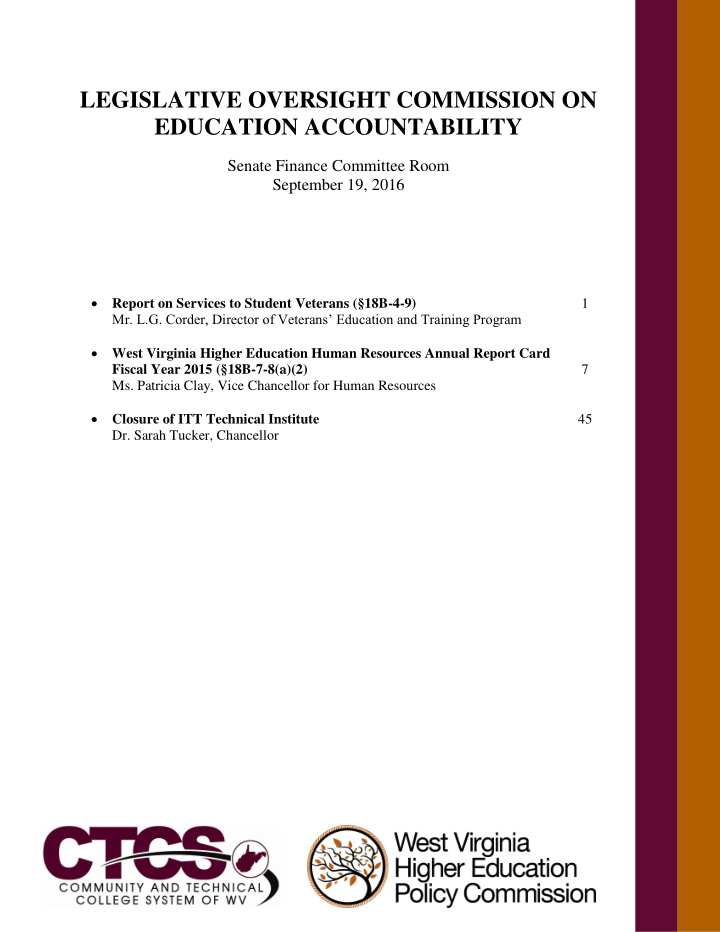



LEGISLATIVE OVERSIGHT COMMISSION ON EDUCATION ACCOUNTABILITY Senate Finance Committee Room September 19, 2016 Report on Services to Student Veterans (§18B-4-9) 1 Mr. L.G. Corder, Director of Veterans’ Education and Training Program West Virginia Higher Education Human Resources Annual Report Card Fiscal Year 2015 (§18B-7-8(a)(2) 7 Ms. Patricia Clay, Vice Chancellor for Human Resources Closure of ITT Technical Institute 45 Dr. Sarah Tucker, Chancellor
Report to the Legislative Oversight Commission on Education Accountability September 19, 2016 Report on Services to Student Veterans (§18B-4-9) 1
2
3
4
5
6
Report to the Legislative Oversight Commission on Education Accountability September 19, 2016 West Virginia Higher Education Human Resources Annual Report Card (§18B-7-8(a)(2)) 7
8
MEMORANDUM TO: Legislative Oversight Commission on Education Accountability FROM: Paul L. Hill Sarah Armstrong Tucker DATE: September 19, 2016 RE: West Virginia Higher Education 2015 Human Resources Report Card West Virginia Code §18B-7-8(a)(2) requires the West Virginia Higher Education Policy Commission (Commission) and West Virginia Council for Community and Technical College Education (Council) to present the annual West Virginia Higher Education Human Resources Report Card to the Legislative Oversight Commission on Education Accountability. After its presentation to LOCEA, this report will be available on the Commission and Council web pages. The West Virginia Higher Education Human Resources Report Card summarizes higher education human resources metrics, expenses, and compensation data by each college and university. The report contains 23 measures that illustrate the diversity in size, structure and operation of the 19 public institutions. Highlights of the report include: The 19 schools employed 12,280 regular employees and 2,225 part-time adjunct faculty at the end of Fiscal Year 2015. The largest category of employees is full-time, benefits-eligible faculty (5,624). o 1,687 in the category of non-classified employees. o 4,969 in the category of classified employees. Full-time faculty are paid considerably lower than their counterparts in other Southern Regional Education Board (SREB) states. The competitive position of average faculty compensation by rank at four-year institutions erodes as faculty progress through academic ranks from instructor to professor. (Page 12) o The index for average faculty salary at the rank of instructor starts at .70 (representing 70% of SREB state average salary for an instructor), peaks at associate 9
professor and falls to .68 for the rank of professor. The competitive position for average faculty salaries at two-year colleges strengthens as faculty progress through academic ranks from instructor to professor. (Page 12) o The index for average faculty salary at the rank of instructor starts at .70 and strengthens to an average index of .80 for the rank of professor. 117 vacant positions have been eliminated. 236 vacant positions have not been filled. 33 employees have been laid off. The institutions reported a total of 128.49 human resources positions. o The full-time equivalent (FTE) number of human resources employees ranged from 1.0 (EWVCTC) to 62.88 (WVU) FTE employees. o Five institutions include payroll as a function of HR and one includes safety and career services. Of the 128.49 HR positions, 8.50 are dedicated to payroll, 1.00 is assigned campus safety, and 2.00 are dedicated to career services, leaving 116.99 employees dedicated to the human resources function in West Virginia higher education colleges and universities. Five colleges and universities (FSU, WVSU, EWVCTC, MCTC, and WVNCC) house the payroll function in Human Resources, leaving fourteen institutions who do not administer payroll directly in Human Resources. This should be considered when evaluating ratio of “ HR Staff ” to the “T otal Number of FTE Employees ” on page 4 and the “ HR Expense ” data against “ Institutional Operating Expenses, ” “ Total Employee Headcount ” and “ Total Employee FTE ” on pages 9, 10 and 11. 2015 Report of Institutional Non-classified Percentages West Virginia Code §18B-9A-1(11) and §18B-7-11(a) defines and limits the number of employees assigned to the category of non-classified for organizations of the Commission and Council. The statute requires the Commission and Council to annually monitor and report organizational progress to the Legislative Oversight Commission on Education Accountability. For 2015 and in the future, this report will be part of the West Virginia Higher Education Human Resources Report Card . By July 1, 2016, the percentage of personnel placed in the category of non-classified at the higher education organization may not exceed 25 percent of the total number of classified and non-classified employees of that organization who are eligible for membership in an authorized retirement system, excluding athletic coaches. Additionally, the statute further restricts assignment in the non-classified category to no more than 10 percent of the number previously described in positions considered by the president to be critical to the institution. The category of “non - classified employee” means an employee of an organization who holds a position that is not assigned a particular job and job title within the classified employee classification system and who meets one or more of the following criteria: 10
(A) Holds a direct policy-making position at the department or organization level; (B) Reports directly to the president or chief executive officer of the organization; or (C) Is in a position considered by the president to be critical to the institution. Page 23 of the West Virginia Higher Education Human Resources Report Card contains information representing the progress made by organizations toward attaining the non-classified limits during Fiscal Year 2015. For 2015, Fairmont State University, Glenville State College and West Liberty State University exceeded the 25 percent total non-classified limit and the 10 percent limit on the number designated “critical to the organization.” West Virginia State University, West Virginia University and Pierpont Community and Technical College exceeded the 25 percent maximum but complied with the limitation of 10 percent in the category “critical to the organization.” Marshall University and West Virginia University at Parkersburg complied with the 25 percent maximum but exceeded the number deemed “critical to the organization.” 11
12
West Virginia Higher Education Human Resources Report Card Fiscal Year 2015 Prepared August 2016 13
Recommend
More recommend